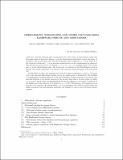| dc.contributor.author | Alekseev, Anton | |
| dc.contributor.author | Naef, Florian | |
| dc.contributor.author | Zhu, Chenchang | |
| dc.contributor.author | Xu, Xiaomeng | |
| dc.date.accessioned | 2018-07-27T13:50:21Z | |
| dc.date.available | 2018-07-27T13:50:21Z | |
| dc.date.issued | 2017-09 | |
| dc.identifier.issn | 0377-9017 | |
| dc.identifier.issn | 1573-0530 | |
| dc.identifier.uri | http://hdl.handle.net/1721.1/117148 | |
| dc.description.abstract | Descent equations play an important role in the theory of characteristic classes and find applications in theoretical physics, e.g., in the Chern–Simons field theory and in the theory of anomalies. The second Chern class (the first Pontrjagin class) is defined as p=⟨F,F⟩ where F is the curvature 2-form and ⟨⋅,⋅⟩ is an invariant scalar product on the corresponding Lie algebra g. The descent for p gives rise to an element ω=ω[subscript 3]+ω[subscript 2]+ω[subscript 1]+ω[subscript 0] of mixed degree. The 3-form part ω[subscript 3] is the Chern–Simons form. The 2-form part ω[subscript 2] is known as the Wess–Zumino action in physics. The 1-form component ω[subscript 1] is related to the canonical central extension of the loop group LG. In this paper, we give a new interpretation of the low degree components ω[subscript 1] and ω[subscript 0]. Our main tool is the universal differential calculus on free Lie algebras due to Kontsevich. We establish a correspondence between solutions of the first Kashiwara–Vergne equation in Lie theory and universal solutions of the descent equation for the second Chern class p. In more detail, we define a 1-cocycle C which maps automorphisms of the free Lie algebra to one forms. A solution of the Kashiwara–Vergne equation F is mapped to ω[subscript 1]=C(F) . Furthermore, the component ω[subscript 0] is related to the associator Φ corresponding to F. It is surprising that while F and Φ satisfy the highly nonlinear twist and pentagon equations, the elements ω[subscript 1] and ω[subscript 0] solve the linear descent equation. Keywords: Chern–Simons form, Kashiwara–Vergne theory, Associators, Kontsevich’s non-commutative differential calculus | en_US |
| dc.description.sponsorship | Swiss National Science Foundation (Early Postdoc.Mobility Grant) | en_US |
| dc.publisher | Springer Netherlands | en_US |
| dc.relation.isversionof | http://dx.doi.org/10.1007/s11005-017-0985-4 | en_US |
| dc.rights | Article is made available in accordance with the publisher's policy and may be subject to US copyright law. Please refer to the publisher's site for terms of use. | en_US |
| dc.source | Springer Netherlands | en_US |
| dc.title | Chern–Simons, Wess–Zumino and other cocycles from Kashiwara–Vergne and associators | en_US |
| dc.type | Article | en_US |
| dc.identifier.citation | Alekseev, Anton, et al. “Chern–Simons, Wess–Zumino and Other Cocycles from Kashiwara–Vergne and Associators.” Letters in Mathematical Physics, vol. 108, no. 3, Mar. 2018, pp. 757–78. | en_US |
| dc.contributor.department | Massachusetts Institute of Technology. Department of Mathematics | en_US |
| dc.contributor.mitauthor | Xu, Xiaomeng | |
| dc.relation.journal | Letters in Mathematical Physics | en_US |
| dc.eprint.version | Author's final manuscript | en_US |
| dc.type.uri | http://purl.org/eprint/type/JournalArticle | en_US |
| eprint.status | http://purl.org/eprint/status/PeerReviewed | en_US |
| dc.date.updated | 2018-02-20T05:32:00Z | |
| dc.language.rfc3066 | en | |
| dc.rights.holder | Springer Science+Business Media B.V. | |
| dspace.orderedauthors | Alekseev, Anton; Naef, Florian; Xu, Xiaomeng; Zhu, Chenchang | en_US |
| dspace.embargo.terms | N | en |
| mit.license | PUBLISHER_POLICY | en_US |
